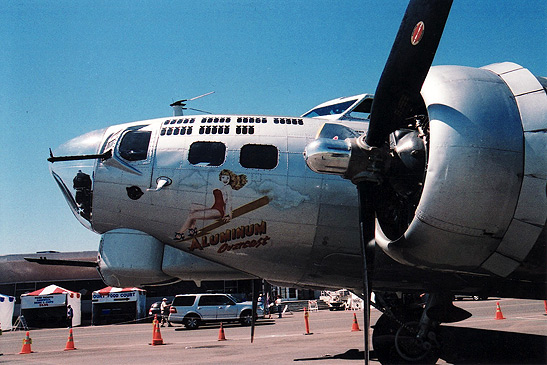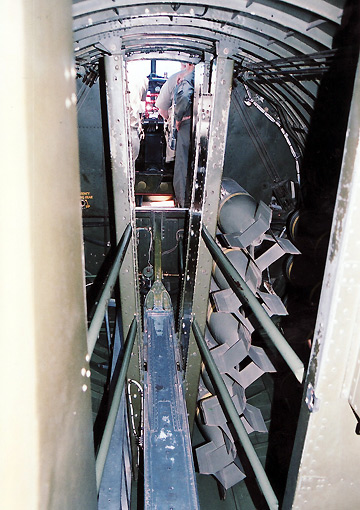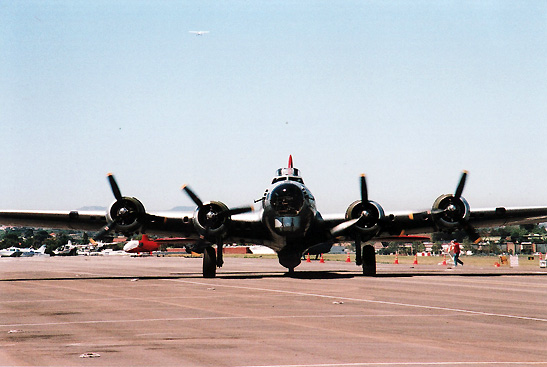|
Flying Aboard An Aviation
Legend!
(Or a Travel Dream Come True) Words and pictures by John Clayton
This one was called Aluminum Overcast, and she was - and is - a Boeing B-17 Flying Fortress bomber. Of the 12, 726 B-17s that were built, 8,670 were G models --- now only about 15 are left in the world. As part of the media, the EAA (Experimental Aircraft Association, based in Oshkosh, Wisconsin) hosted me and other journalists for a brief flight over Torrance in southern California, that included a marvelous bird's eye view of the stunning Palos Verdes Peninsula. When you see Hollywood movies about WW2, and B-17's are part of the story, one tends to get the impression that the aircraft is quite roomy inside. Not true, it is very narrow and very confining. I'm six foot two and I was not able to stand upright! Growing up in London, in Great Britain, I knew all about the B-17 and its role in WW2, and to actually fly aboard the plane was not only a dream come true, but also a magical, mystical, marvelous experience - and it made me think about the brave US flight crews who flew this magnificent bird in that conflict, and the trials and tribulations (and yes, mind numbing terror) they went through as they completed their 25 or later 30 and then 35 missions, in Europe. Before you board the aircraft on the "Flight seeing" trips, the media have to "check in" at a special booth (it's actually a sort of caravan that both inside and out, "promotes" the EAA B-17) and after signing a form that basically says you won't sue the EAA, you're given this (I thought) wonderful small blue card that - sort of like the commercial airline industry of days gone by - says "Welcome Aboard." But when you read the first sentence, it makes you wonder how safe it'll be fly this aviation legend - the words that greet your eyes say that although the aircraft has a "Limited Airworthiness Certificate," it is not a so called "Standard Airworthiness Certificate." Then this great line. "This does not mean the aircraft is unsafe." Wow!!! The next few sentences really put your worries to rest as they inform you that the training and crews who fly this EAA B-17 have "more training and experience" than one finds in most sight seeing type operations. Further down this blue colored, small sheet, are some words about the engines - "Four Curtis Wright 1820-97 engines power the B-17…and they have an excellent record" It then goes on to tell you that if, for whatever reason it might be necessary to actually shut the engines down (notice that's in the plural!) during the flight, "The aircraft flies quite well on three - or even two, should the unexpected occur." History and aviation buffs will tell you, as indeed will B-17 flight crews who flew this marvelous war horse, that the aircraft could take extraordinary punishment, and still get the boys safely home. Tails half shot off, wings peppered with literally hundreds of enemy machine gun bullets, fuselages that appeared to be almost smashed to smithereens, and still this wonderful, incredible piece of flying machinery, would bring their crews and planes back to England. As some British newspapers reported on seeing them after landing, "it was a miracle how they even managed to fly." Although the B-24 Liberator could carry more bombs than the B-17, the Flying Fortress was the aircracft that captured the public's imagination. Just like the Spitfire and Hurricane fighters that grabbed the attention of the population in those now far away days, it was the Spitfire that got all the attention. The Hurricane actually shot down more enemy planes during the Battle of Britain, but it was the more glamorous Spitfire that, like the B-17, mesmerized the public. There are so many reasons why you should take this EAA B-17 flight, but one of the things that I loved was - and it's stated in their Welcome Aboard booklet - is that you are more than welcome to leave your seats during the flight, and to walk through the aircraft; to walk above the bomb bay area; and even enter the cockpit; or go down into the nifty nose section. You are also encouraged to ask the crew any questions about the B-17, and other aspects of the flight and the aircraft's operation. Because so many American flight crews made the ultimate sacrifice in WW2 with their lives, I thought it was wonderful that this aspect of their service to their country is noted in the last paragraph of the EAA Welcome Aboard flyer. It says, quote, "It is a real pleasure for us to share this opportunity with you. We feel it will enhance your knowledge of the B-17 aircraft and give you, as it has us, a greater appreciation for those men who risked their lives to protect our freedom over 50 years ago. Every flight taken by this aircraft is in honor of those gallant men. Please treat the aircraft with respect, as it represents a window into history and hopefully, with the assistance of people such as you, we will be able to demonstrate this aircraft for many years to come." Then in large letters this…. Welcome Aboard!
The B-17G Aluminum Overcast was "born" on May 18th, 1945 when she was delivered to the US Army Air Corps. She was too late to actually fly in WW2, and for nearly 30 years she came very near -- countless times -- to being sold as scrap. In fact in the summer of 1946 she was sold to a scrap dealer in New Jersey for all of $760!!! During her "years in the wilderness" she performed a wide range of duties from crop dusting to cargo carrier, hauling (of all things!) cattle in Florida and Puerto Rico. Of the 12, 727 B-17s that were built, 8,670 were the G model like Aluminum Overcast. Lovingly restored by the EAA over a 10 year period beginning in 1979, she now proudly carries the colors of the 398th Bomb Group of WW2 which flew hundreds of missions over Nazi held territory. She commemorates another B-17 of that name that was shot down over France on its 34th mission on August 13th, 1944. Every year she flies hundreds and hundreds of miles throughout the USA and Canada giving flights and tours on this superb flying machine -- as you'll see at www.b17.org.
You may wonder, looking at THIS photo (taken from inside the B-17) what on earth it is. It's probably the most dangerous position in the B-17 - the ball turret that "hangs" below the center of the aircraft. You are cut off from the rest of your crew; it's exceedingly hazardous to your health as enemy fighters could blast the turret very easily as they swept by underneath the B-17 at hundreds of miles an hour and, even more terrifying, as it was hydraulically controlled, if the aircraft lost its hydraulics you were often doomed to die when the aircraft had to make a "wheels up" belly landing. Yes, of course it could be manually operated, but that took precious time, and if there were injured crew on board, and landing on your return to England was the only thing that mattered, there were instances when a B-17's landing gear would not come down, and the plane had to do a belly landing - so killing the gunner in his ball turret.
All my life I've sought to take innovative, creative photographs, but this was one "situation" that I found almost irresistible. When you board the B-17 and sit, as I did, in what used to the radio operator's position on the port (or left hand) side of the plane, you notice a huge, well sort of hole or large opening in the top part of the fuselage. When I asked the EAA Chief Pilot, Sean Elliot what it was, he said that "it's actually a gun port, where there used to be a 50caliber gun that slid into position here once the hatch is taken out. We leave it (the hatch) out for ventilation reasons." I leaned out as far as I dared, but was VERY careful NOT to lean out too far as the thought of getting sucked out was not on my agenda that day! Or any other, for that matter!
In case you're wondering about the opening discussed in the previous photo, I also show you this for a reference point. As you see looking at this photo, there IS a large black colored opening just aft (behind) the upper gun turret - that's where this opening is on this B-17.
As Aluminum Overcast moves towards you, you see and hear
an aviation legend come to life - and it's an amazing and stirring sight! |





